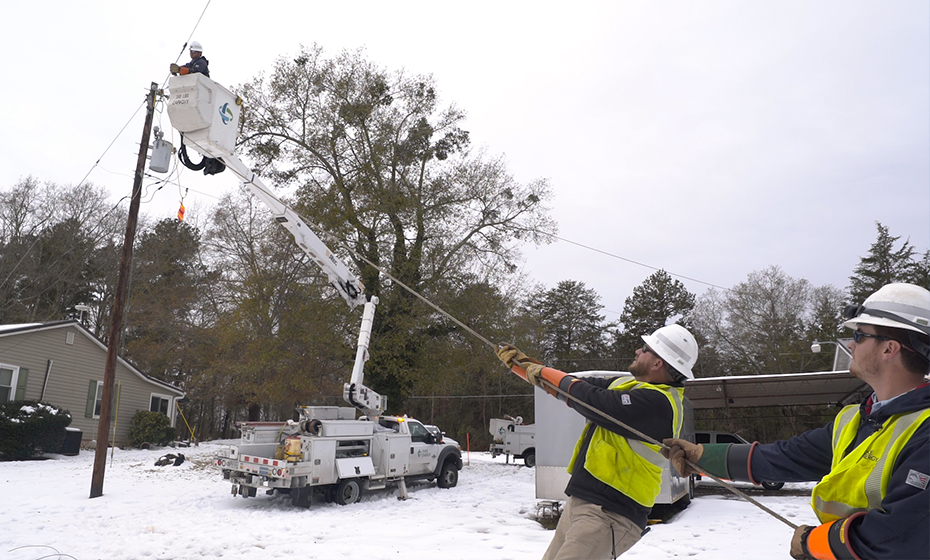
A winter storm continues to move through the Carolinas today, cutting power to 67,000 Duke Energy customers so far, with more power outages likely to occur later today and into early Monday.
Power outages in some areas might last several days, depending on conditions.
As of 11:15 a.m. today, 27,000 customers in North Carolina and 40,000 in South Carolina had no power.
Hardest hit counties
So far, North Carolina’s hardest hit counties, in terms of power outages, include: Gaston, Jackson, Macon and Swain.
South Carolina’s hardest hit counties for power outages so far include: Anderson, Darlington, Florence, Greenville, Greenwood, Kershaw, Oconee, Pickens, Spartanburg and Sumter.
“I thank our customers, in advance, for their patience and understanding during what could be a multi-day power-restoration process, given the expected widespread damage to our electric distribution system across both states,” said Jason Hollifield, Duke Energy Carolinas storm director.
“Our crews are ready to begin power restoration as soon as weather conditions safely allow, but ongoing hazardous weather and dangerous road conditions initially will slow our ability to assess damage, make repairs and estimate power restoration times,” Hollifield said.
11,000 response workers from multiple states
In advance of the storm, Duke Energy strategically staged more than 11,000 workers – power line technicians, damage assessors and vegetation workers – across the Carolinas.
Those workers include Duke Energy crews normally based in Florida, Indiana and Ohio – and mutual assistance crews from other companies in Canada, Texas, Arizona, Wisconsin, Louisiana, Oklahoma and other states – who traveled to the Carolinas to assist North Carolina- and South Carolina-based Duke Energy workers.
Heavy ice on trees, branches, power lines
Ice buildup on trees and branches that causes them to fall on power lines is usually the main culprit behind power outages during a winter storm. Specifically, ice buildup of a quarter-inch or more is often the threshold amount that causes trees and branches to topple.
The heavy weight of significant ice buildup directly on power lines themselves can sometimes cause the lines to fall or sag, as well. Heavy, wet snow of six inches or more also can cause trees and branches to fall on power lines.
Damage assessment
After the storm, as conditions permit, crews will begin assessing the extent of damage – a process that can take 24 hours or more following storms that cause widespread damage and hazardous driving conditions.
Damage assessments determine the types of crews, equipment and supplies needed to restore power.
Power restoration crews will begin working immediately after the storm as soon as it’s safe to do so. Restoration efficiency improves as damage assessment information is available to ensure the right workers and materials are dispatched to each power outage location.
Keeping customers informed
Customers can report power outages by texting “OUT” to 57801, and find the most up to date information on the company’s outage map.
Duke Energy will provide estimated power restoration times to impacted customers as soon as the company can accurately determine those estimated times, which likely will be Monday.
The company also will provide regular updates to customers and communities through emails, text messages, outbound phone calls, social media and its website, which includes power outage maps.
Duke Energy is working closely with state officials in both North Carolina and South Carolina. Both states provide emergency information – North Carolina, South Carolina.
Duke Energy serves 4.3 million customers in the Carolinas – 3.5 million in North Carolina; 800,000 in South Carolina.
Duke Energy’s power restoration process
More information about how crews restore power after a major storm – restoration process.
Important safety information for customers
Ensure an adequate supply of flashlights, batteries, bottled water, non-perishable foods, medicines, etc., as well as the availability of a portable, battery-operated radio, TV or weather radio.
Customers should make alternate shelter arrangements as needed if you will be significantly impacted by a loss of power – especially families who have special medical needs or elderly members.
If a power line falls across a car that you’re in, stay in the car. If you MUST get out of the car due to a fire or other immediate life-threatening situation, do your best to jump clear of the car and land on both feet. Be sure that no part of your body is touching the car when your feet touch the ground.
Ice and snow can cause hazardous driving conditions resulting in traffic accidents and downed utility poles and power lines that, in turn, can cause isolated power outages. If you’re driving and encounter emergency responders or other roadside work crews, remember to MOVE OVER.
If you use a generator due to a power outage, follow the manufacturer’s instructions to ensure safe and proper operation. Operate your generator outside; never operate it inside a building or garage.
Don’t use grills or other outdoor appliances or equipment indoors for space heating or cooking, as these devices may emit carbon monoxide.
Stay away from power lines that have fallen or are sagging. Consider all lines energized as well as trees or limbs in contact with lines. Please report downed power lines to Duke Energy or local emergency services.
Be prepared for an emergency by purchasing an emergency preparedness kit from the Red Cross.
More tips on what to do before, during and after a storm can be found at duke-energy.com/safety-and-preparedness/storm-safety. A checklist serves as a helpful guide, but it’s critical before, during and after a storm to follow the instructions and warnings of emergency management officials in your area.
Shelter information
If you lose power and need to move to a shelter, North Carolina and South Carolina state websites provide emergency shelter information – North Carolina, South Carolina.
In addition, the Red Cross maintains an update-to-date list of open shelter locations – https://www.redcross.org/get-help/disaster-relief-and-recovery-services/find-an-open-shelter.html.
Follow CDC recommendations for staying safe and healthy in a public disaster shelter during the COVID-19 pandemic.
How to protect refrigerated food during power outages
For customers who lose power and have full refrigerators and freezers, the U.S. Food and Drug Administration (FDA) recommends the following:
Keep refrigerator and freezer doors closed as much as possible to maintain the cold temperature.
A refrigerator can keep food cold for about four hours if it is unopened. If the power will be out for more than four hours, use coolers to keep refrigerated food cold.
A full freezer will keep the temperature for approximately 48 hours (24 hours if it is half full) if the door remains closed.
The FDA offers additional tips for proper food handling and storage before, during and after a power outage at www.fda.gov/food/buy-store-serve-safe-food/food-and-water-safety-during-power-outages-and-floods.
Avoid customer scams
Customers should be alert to scammers who might call them – impersonating Duke Energy representatives and threatening to cut off customers’ power before or during the storm unless customers make an immediate payment for late bills or other charges.
Duke Energy never makes such calls.
Below are tips for customers to avoid such scams:
If it’s a recorded voice, often referred to as a “robocall,” be extra cautious.
Do not provide any personal information.
Duke Energy’s actual recorded calls to customers are informative only. The company’s calls never threaten to cut off power and never request personal information.
If a caller – recorded or live – specifically asks you to pay using a prepaid debit card, that’s a red flag. Prepaid debit cards are like cash and the transactions cannot be reversed.
If the caller pressures you to make an immediate payment of any type – or provide personal information of any kind, such as a bank account number or social security number – hang up the phone.
Sign up for outage alerts
Customers can receive the most up-to-date information about power restoration efforts by enrolling in Outage Alerts.
How to report power outages
Customers who experience a power outage can report the outage using Duke Energy’s automated outage-reporting systems for their respective utility:
Customers can report an outage by texting “OUT” to 57801, and also report an outage or view current outages on the Duke Energy mobile app or at www.duke-energy.com/outages.
Duke Energy Carolinas: 1.800.POWERON (1.800.769.3766)
Duke Energy Progress: 1.800.419.6356
Duke Energy also will provide updates on its social media channels to keep customers informed if significant outages occur:
Duke Energy on Twitter: twitter.com/DukeEnergy
Duke Energy on Facebook: facebook.com/DukeEnergy
View B-roll of storm preparations and winter storm power restoration efforts
Duke Energy
Duke Energy (NYSE: DUK), a Fortune 150 company headquartered in Charlotte, N.C., is one of America’s largest energy holding companies. Its electric utilities serve 7.9 million customers in North Carolina, South Carolina, Florida, Indiana, Ohio and Kentucky, and collectively own 51,000 megawatts of energy capacity. Its natural gas unit serves 1.6 million customers in North Carolina, South Carolina, Tennessee, Ohio and Kentucky. The company employs 27,500 people.
Duke Energy is executing an aggressive clean energy strategy to create a smarter energy future for its customers and communities – with goals of at least a 50% carbon reduction by 2030 and net-zero carbon emissions by 2050. The company is a top U.S. renewable energy provider, on track to own or purchase 16,000 megawatts of renewable energy capacity by 2025. The company also is investing in major electric grid upgrades and expanded battery storage, and exploring zero-emitting power generation technologies such as hydrogen and advanced nuclear.
Duke Energy was named to Fortune’s 2021 “World’s Most Admired Companies” list and Forbes’ “America’s Best Employers” list. More information is available at duke-energy.com. The Duke Energy News Center contains news releases, fact sheets, photos and videos. Duke Energy’s illumination features stories about people, innovations, community topics and environmental issues. Follow Duke Energy on Twitter, LinkedIn, Instagram and Facebook.
Media contact: 800.559.3853
OVERVIEW
OnMyWay Is The #1 Distracted Driving Mobile App In The Nation!
OnMyWay, based in Charleston, SC, The Only Mobile App That Pays its Users Not to Text and Drive.
The #1 cause of death among young adults ages 16-27 is Car Accidents, with the majority related to Distracted Driving.
OnMyWay’s mission is to reverse this epidemic through positive rewards. Users get paid for every mile they do not text and drive and can refer their friends to get compensated for them as well.
The money earned can then be used for Cash Cards, Gift Cards, Travel Deals and Much, Much More….
The company also makes it a point to let users know that OnMyWay does NOT sell users data and only tracks them for purposes of providing a better experience while using the app.
The OnMyWay app is free to download and is currently available on both the App Store for iPhones and Google Play for Android @ OnMyWay; Drive Safe, Get Paid.
Download App Now – https://r.onmyway.com
Sponsors and advertisers can contact the company directly through their website @ www.onmyway.com.

OnMyWay is the Only Texting and Driving Solution That Pays
Trusted and 











